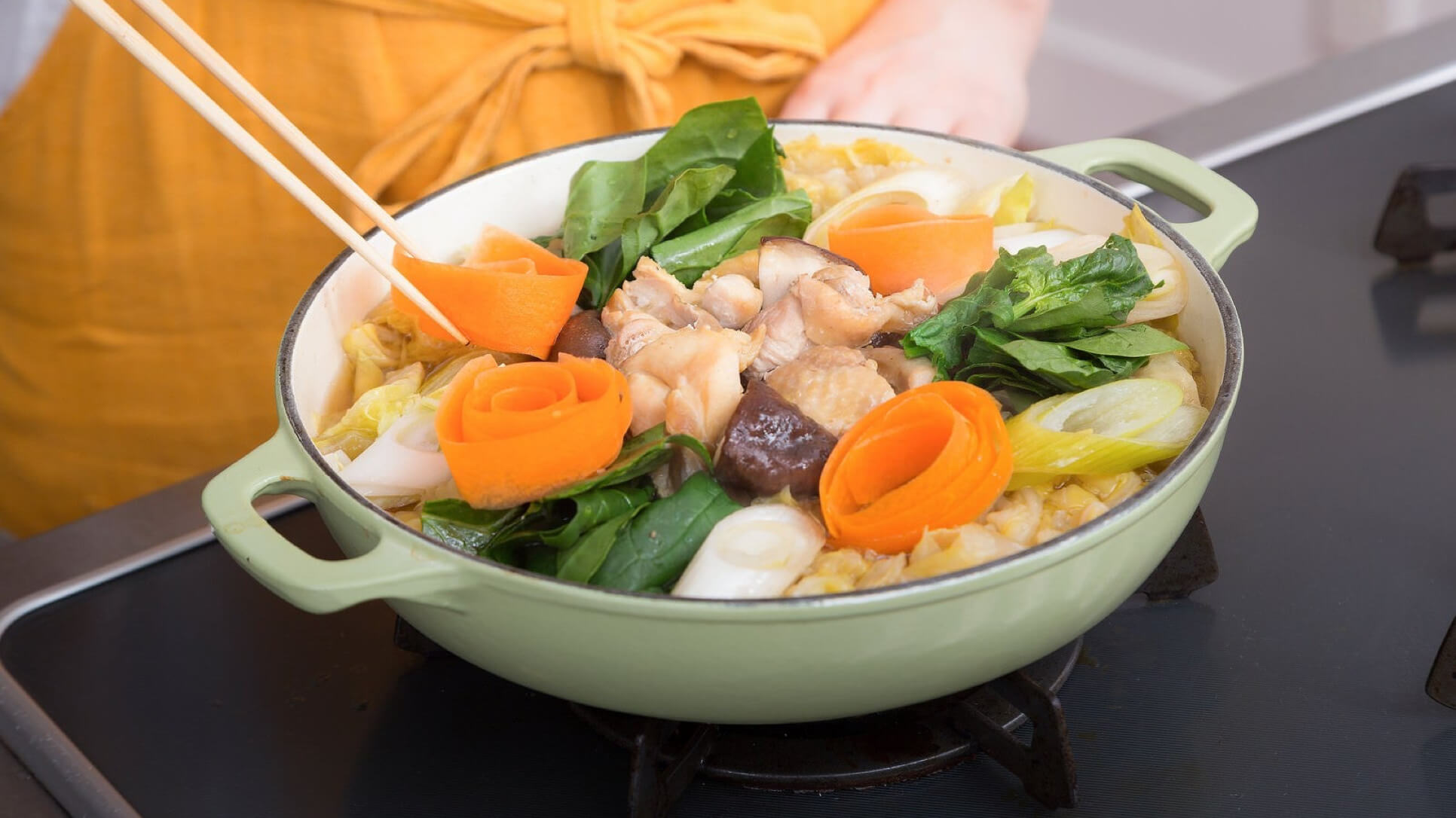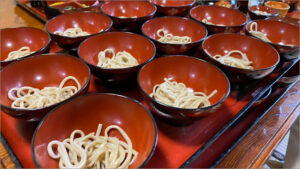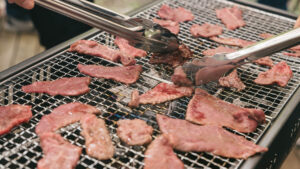“Razor-sharp knives,” “graters that create fluffy textures,” and “donabe pots crafted with artisan skill”—
Japanese kitchen tools are more than just cooking utensils; they are trusted companions that make cooking more enjoyable.
Their global popularity stems from a perfect balance of functionality, beauty, and long-lasting quality.
In this article, we’ll introduce beginner-friendly Japanese kitchen tools, how to choose the right ones, and tips for getting the most out of them.
Why not bring a touch of Japan’s thoughtful and refined lifestyle into your kitchen?
Contents
Why Are Japanese Kitchen Tools Loved Around the World?
Japanese kitchen tools are highly regarded by cooking enthusiasts and professional chefs worldwide for their ease of use, aesthetic appeal, and long-lasting durability. The Japanese spirit of craftsmanship, which values both function and beauty, is deeply reflected in these tools. Many users say they can feel the difference the moment they pick one up. In this section, we’ll explore the exceptional quality of Japanese kitchen tools by focusing on the artisan techniques behind their creation.
Craftsmanship That Creates Exceptional Quality
Knife-Making Regions: Seki and Sakai
Seki City in Gifu Prefecture and Sakai City in Osaka are known as the meccas of Japanese knife-making. These areas have inherited the traditional skills of samurai swordsmiths, and today, artisans still handcraft each knife one by one. With their outstanding sharpness, perfect balance, and impressive durability, these knives go beyond mere cooking tools—they are true works of art.
Handcrafted Graters with Precision
Japanese graters are far from ordinary kitchen utensils. In particular, copper graters are hand-finished by craftsmen who carefully create each blade by hand. This precise craftsmanship allows ingredients like daikon radish and ginger to be grated into a light, fluffy texture, preserving their original flavor and aroma. The attention to detail transforms this simple tool into something truly exceptional.
Traditional Crafts in Ceramics and Woodwork
Many Japanese kitchen tools incorporate elements of traditional crafts such as pottery and woodworking. For example, donabe clay pots and dashi pots are crafted in kilns like Shigaraki and Banko, known for their excellent heat retention and durability. Items like bento boxes made from magewappa (bent cedar) or wooden serving trays often use domestic woods such as Akita cedar or Japanese cypress, combining natural beauty with functionality. Each time you use these artisan-made tools, you’ll experience the essence of a thoughtful, refined lifestyle.
Balance of Functionality and Aesthetic Design
Japanese kitchen tools are designed with no compromise between usability and visual beauty. They are crafted to make daily cooking more efficient while also serving as elegant, minimalist decor pieces that enhance the look of your kitchen. This unique balance is one of the reasons why these tools are loved by users around the world. Let’s explore how this harmony is reflected in their design.
Compact and User-Friendly Shapes
Developed with Japan’s compact housing in mind, Japanese kitchen tools are designed to maximize efficiency in limited spaces. For example, the yukihira nabe (lightweight saucepan) is easy to handle thanks to its lightweight body, long handle, and spouted rim for easy pouring. Graters are often designed to stand upright or come integrated with small plates, balancing space-saving design and functionality. These tools are crafted with practical features that make them easy for anyone to use from day one.
Beautiful Enough to Be Seen
Japanese kitchen tools are so beautifully crafted that they can be brought straight from the kitchen to the dining table without looking out of place. Tools made from natural materials like bamboo and wood, or warm ceramic finishes, offer a sense of calm with every use. Lacquerware-like finishes and the earthy textures of traditional pottery give them an artistic presence, making them more than just functional items—they’re lifestyle pieces that bring charm to your everyday routine.
A Natural Fit for Any Kitchen Style
Thanks to their simple and functional designs, Japanese kitchen tools easily blend into various kitchen aesthetics, including Scandinavian and modern styles. The natural materials and subdued colors complement a wide range of interiors, making them perfect for mixing Japanese and Western styles alike.
More products now include English instructions, making them accessible even to first-time users. Quietly but surely, Japanese kitchen tools are integrating into kitchens and lifestyles across the globe.
Tools That Match the Delicacy of Japanese Cuisine
Japanese cuisine emphasizes bringing out the natural flavors of ingredients, and it’s the uniquely Japanese kitchen tools that support this delicacy. Rather than bold presentation, washoku (Japanese cuisine) values careful preparation and subtle techniques. In such a style of cooking, the quality of the tools used can have a direct impact on flavor. Here, we’ll introduce some essential tools that help embody the spirit of Japanese cooking.
Dashi Culture and the “Dashi Pot”
The foundation of Japanese flavor is dashi, a gentle umami-rich broth made from kombu (kelp), katsuobushi (bonito flakes), and other natural ingredients. Recently, dashi pots have gained popularity for making authentic broth easily at home. Just place the ingredients and water in the pot and heat—it extracts a clear, aromatic dashi that brings depth to everyday dishes.
There are also simpler types that work with just hot water, making it easy to incorporate traditional dashi-making into overseas kitchens. These tools allow anyone to enjoy the essence of Japanese cuisine with minimal effort.
Cooking Tools That Bring Out the Natural Flavor
Japanese cuisine uses methods like simmering, steaming, and grilling in a refined, intentional way to preserve and enhance the flavor and texture of ingredients. Accordingly, the tools are crafted to support and draw out the best qualities of each ingredient.
For example, donabe (earthenware pots) use far-infrared heating to cook food evenly, making perfect rice or hearty stews. Bamboo seiro steamers gently steam vegetables, allowing their natural sweetness to shine through. These tools do more than look beautiful—they actually improve the results of your cooking.
Tools That Make Any Dish Feel Authentically Japanese
Just by using Japanese kitchen tools, you can add a sense of authenticity and “Japanese atmosphere” to your cooking. For example, using a bamboo makisu (sushi rolling mat) to roll sushi or an otoshibuta (drop lid) to simmer vegetables brings traditional elegance to the presentation.
Presentation plays an important role in Japanese cuisine, and combining these tools with lacquered bowls, chopsticks, or ceramic dishes helps recreate the ambience of a traditional Japanese restaurant. Even without professional skills, the right tools make it easier to prepare food that feels truly Japanese—that’s the magic of these kitchen essentials.
Recommended Japanese Kitchen Tools by Category
One of the greatest appeals of Japanese kitchen tools is their incredible variety and purpose-driven design. From cutting and grating to boiling, steaming, plating, and more—there are specialized tools for each step of the cooking process. These tools don’t just make cooking easier; they make it more enjoyable. In this section, we’ll explore some of the best Japanese-made tools, organized by function and use.
Cutting and Grating Tools
In Japanese cooking, which focuses on enhancing the natural flavor of ingredients, cutting and grating tools like knives and graters play a crucial role. Japanese blades and graters are known for their exceptional sharpness and ease of use, greatly improving both the precision and efficiency of your cooking.
Santoku vs. Gyuto Knives
The santoku knife is one of the most commonly used knives in Japanese households. As its name suggests—santoku means “three virtues”—this all-purpose knife is designed to handle meat, fish, and vegetables. Its slightly wider blade offers stability, making it an ideal choice for everyday cooking and a great first knife for beginners.
In contrast, the gyuto knife originates from Western-style cutlery but has been refined in Japan to offer superior sharpness and sleek design. It’s ideal for more delicate tasks such as slicing meat thinly or performing precise cuts.
By using each knife based on its strengths and the type of dish you’re preparing, you can dramatically expand your cooking repertoire and achieve better results.

Zwilling TWIN Pollux 2-Piece Knife Set
Made in Seki, Japan. A versatile Santoku and petty knife set, perfect for daily use or as a gift.
Specialized Knives: Sashimi and Deba Knives
When preparing dishes unique to Japanese cuisine—like sashimi or whole fish—specialized knives are essential. The sashimi knife (also known as yanagiba) features a long, thin blade designed to slice through raw fish in a single, smooth motion. This technique creates clean cuts that preserve the texture and appearance of the fish.
The deba knife is thicker and heavier, ideal for tasks like filleting and butchering whole fish. Its robust blade allows you to cut through bones, split fish heads, and perform other heavy-duty work with ease.
These knives are not just for professional chefs—they’re also highly recommended for home cooks who enjoy handling fresh fish and exploring traditional Japanese food preparation.

Sakai Genkichi Deba Knife 150mm
Traditional deba knife with a 15cm tree-pattern blade, handcrafted by Genkichi in Sakai, Japan.

Masterpiece Kanesada Deba Knife 150mm
A 150mm deba knife crafted by Kanesada. Durable blade and broom wood handle. Made in Japan.

Satake Sashimi Knife 170mm
A 170mm sashimi knife with a sharp molybdenum blade and durable wood handle. Made in Japan.
Graters (Copper, Ceramic, Bamboo, etc.)
Japanese graters are deep and versatile tools that vary in result depending on their material and design.
Copper graters are handcrafted by skilled artisans who carefully create sharp grating edges by hand, resulting in fluffy and finely grated daikon. These are highly durable and built to last, making them ideal for serious cooks.
Ceramic graters are lightweight, easy to handle, and rust-resistant—perfect for everyday use. They are also easy to clean, making them convenient for grating ginger or daikon on a daily basis.
Bamboo graters offer a gentle grating experience, ideal for finely grating ginger or fresh wasabi. Their natural look and feel add charm to any kitchen, and their use of eco-friendly materials is another reason for their growing popularity.

Shimomura Kihan Grated Meijin Sluran
Durable stainless steel grater with heat-resistant container. Compact and easy to use. Made in Japan.

TIKUSAN Oroshigane Japanese Grater
Authentic Japanese oroshigane for grating daikon, ginger, and more. Durable, rust-resistant steel.

Japanese Oroshigane Grater with Handle
Compact, ergonomic grater for ginger, garlic, and more. Bowl-fixable design. Made in Niigata, Japan.
Cooking & Steaming Tools
Simmered and steamed dishes are fundamental techniques in Japanese cuisine. Japanese-made cooking and steaming tools are designed to draw out the natural umami of ingredients and create refined, delicate flavors. Tools such as Yukihira pots, earthenware pots (donabe), and traditional steamers (seiro) not only offer excellent functionality but also elevate the overall quality of your dishes.
Charm of Yukihira Pots and Donabe
The Yukihira pot is a traditional Japanese one-handled pan made of aluminum or copper, used in households for generations. It’s lightweight and easy to handle, with a spout that makes transferring broth or soup effortless. Its excellent heat conductivity makes it ideal for simmering dishes or boiling water. The wooden handle stays cool to the touch, making it a practical tool for daily use.
On the other hand, the donabe (earthenware pot) excels in heat retention, allowing ingredients to cook thoroughly and gently. It’s perfect for cooking rice, enjoying hot pot dishes, or preparing seasonal meals. Even after the heat is turned off, residual heat continues to cook the food, making it energy-efficient.
Both of these pots are deeply rooted in Japanese daily life and have gained high praise from those around the world who seek authentic flavors in their cooking.

MARUYAMA GIKEN KOURIKKA Yukihira Saucepan 22cm
Traditional 3.2 qt Yukihira saucepan with wood handle, dual spouts, and hammered steel. Made in Japan.

Endoshoji QDN08024 Earthenware Pot 24cm
Durable 24cm earthenware-aluminum pot for induction cookers. Professional quality. Made in Japan.

Endoshoji QDN1130 Shinkoraku Pot 30cm
30cm handmade earthenware-aluminum pot, induction-compatible. 3.0L capacity. Made in Japan.
How to Use Dashi Pots and Teapots
A dashi pot is a convenient tool that allows you to easily extract flavorful dashi from ingredients like kombu (kelp) and katsuobushi (bonito flakes). Many are made from heat-resistant glass or ceramic, and all you need to do is add the ingredients and pour in hot water to enjoy a rich, aromatic broth. They are especially recommended for people living abroad who want to enjoy authentic Japanese cuisine in their daily life.
Teapots that also function as kyusu (Japanese tea pots) are versatile items, suitable not only for Japanese tea but also for herbal or black teas. Their elegant forms and practical features make them a popular item to brighten up your dining table. From clear glass types to ceramic teapots made in Shigaraki ware, the choice of material adds unique character and atmosphere to your tea experience.

Japanese Tokoname Kyusu Teapot by Isshin
Handcrafted Tokoname clay teapot with stainless strainer. 11.5 fl oz. Made by Isshin Kiln, Japan.

Tokoname Red Kyusu Teapot
Easy-to-use Tokoname teapot with fine mesh filter. Ideal for sencha and Fukamushi. Made in Japan.

Japanese Mino Ware Kyusu Teapot & Yunomi Set
Elegant Mino ware teapot and cup set with aurora glaze. 13.5 fl oz. Made in Japan.
How to Use Steamers and Seiro (Bamboo Steamers)
Steamers and bamboo steamers (seiro) are excellent cooking tools that preserve the natural flavor and nutrients of ingredients.
Metal steamers heat up quickly and offer outstanding durability, making them ideal for perfectly steaming dishes like shumai dumplings and chawanmushi (savory egg custard).
On the other hand, bamboo steamers gently release steam, resulting in moist and tender textures.
They’re perfect for steaming buns, vegetables, and even reheating rice.
The subtle aroma of the bamboo adds warmth and depth to the dishes.
Their stackable design and aesthetic beauty are also part of their appeal, gaining popularity among natural lifestyle enthusiasts overseas.
Charm of Magewappa and Bamboo Bento Boxes
Magewappa is a traditional Japanese lunch box made from natural wood such as Akita cedar. Crafted using a bending technique, it absorbs excess moisture from rice, keeping it soft and delicious even after hours.
Bamboo bento boxes are also lightweight and breathable, helping prevent food from becoming soggy and preserving its original flavor. Both types offer a warm, natural aesthetic that elevates lunchtime into a special moment.
These handcrafted lunch boxes are gaining popularity overseas as “Japanese lunch boxes” and are also appreciated as thoughtful, stylish gifts.

Akita Cedar Magewappa Bento Box Medium
Handcrafted from Akita cedar, this 640ml bento box is lightweight, organic, and made in Japan.

Miyoshi Shikki Magewappa Bento Box 700ml
700ml cedar bento box with urethane finish and elegant patterns. Durable, easy to clean. Made in Japan.

IPPINKA Magewappa Bento Box Medium
600ml handcrafted cedar bento box from Akita. Lightweight, durable, and dishwasher-safe. Made in Japan.
Japanese-Style Storage Containers with Excellent Sealing
Japanese-style food containers combine functionality and elegant design, making them ideal for both preservation and presentation.
For example, enameled containers are resistant to odor and acid, making them perfect for storing pickles or miso.
Ceramic containers are also popular for their stability at room temperature, making them suitable for storing dried foods and tea leaves.
Their hand-painted patterns and traditional motifs turn even a refrigerator into a place of aesthetic charm.
In addition, modern designs such as glass jars with wooden lids are gaining popularity worldwide, blending Japanese minimalism with contemporary style.
Entertaining with Jubako Boxes and Lacquerware
Jubako boxes and lacquerware, traditionally used for New Year’s celebrations and formal meals, are iconic elements of Japan’s hospitality culture.
Layered stacking allows for beautiful, elegant food presentation that enhances the overall dining experience.
Jubako boxes come in a wide range of styles, from classic lacquer finishes to modern designs.
Recently, they’ve also become popular for picnics and home parties. Simply filling them with food creates a sense of occasion, making them ideal even for those who aren’t confident in the kitchen.
Lacquerware bowls and plates feature rich colors and elegant gloss that elevate simple dishes, giving everyday meals a refined, restaurant-like atmosphere.

JapanBargain 4119 Jubako Box
Elegant 3-tier plastic lacquered Jubako box with crane motif. Ideal for snacks or bento. Made in Japan.

J-kitchens Heavy Jubako Box
Sturdy 3-tier ABS resin jubako box in traditional Matsukasa design. Elegant and durable. Made in Japan.

Mitani Yamanaka Lacquerware Soup Bowl
Lightweight 4.3″ resin soup bowl with natural texture. Microwave & dishwasher safe. Made in Japan.
Top 3 Essential Japanese Kitchen Tools for Beginners
Japanese kitchen tools come in many varieties, but you don’t need to collect everything at once.
If you’re new to cooking or want to try Japanese cuisine, there are a few core items that are perfect to start with.
Here, we introduce three highly recommended tools that combine ease of use with versatility.
1. All-Purpose Kitchen Knife (Santoku)
If you’re beginning your cooking journey, owning one good knife is essential.
The “Santoku” knife, commonly used in Japanese households, is a versatile tool ideal for cutting meat, fish, and vegetables.
It’s the perfect choice as your first knife.
Features of the Santoku Knife
Santoku knives usually have a blade length of around 16–18 cm, making them well-suited for smaller hands.
The rounded tip allows for both push and pull cuts.
From chopping vegetables to slicing meat and filleting fish, this knife covers nearly all daily cooking tasks.
Its design is all about practicality and balance.
Balanced and Easy for Beginners
With excellent weight distribution between the blade and handle, the Santoku knife is easy to control even for first-time users.
It feels natural in the hand and reduces fatigue during extended use.
Japanese-made knives often feature non-slip, ergonomic grips for added safety and comfort—great for beginners.
Sharpening and Lifespan
Japanese knives can last for many years with proper care.
If the blade becomes dull, it can be easily resharpened using a whetstone or sharpener.
The straightforward shape of a Santoku knife makes it relatively easy to maintain.
With regular care, a good Santoku knife can stay sharp and reliable for 5 to 10 years or more, keeping your cooking experience smooth and enjoyable.

Sakai Genkichi Deba Knife 150mm
Traditional deba knife with a 15cm tree-pattern blade, handcrafted by Genkichi in Sakai, Japan.

Masterpiece Kanesada Deba Knife 150mm
A 150mm deba knife crafted by Kanesada. Durable blade and broom wood handle. Made in Japan.
2. Ceramic Grater
The “grater” is a practical kitchen tool commonly used in Japanese households. Ceramic graters, in particular, are a popular choice for beginners thanks to their ease of handling and simple maintenance. They’re perfect for effortlessly grating ginger, daikon, garlic, and other condiments, enhancing the aroma and flavor of your dishes.
Lightweight and Easy to Clean
Ceramic graters are significantly lighter than metal or copper ones, making them very easy to handle. Unlike pottery or resin tools, they don’t rust and can be kept clean with just a quick rinse using a sponge.
Some models are even microwave-safe, allowing you to warm up the grated ingredients directly. Ideal for those who value speed and cleanliness in everyday cooking.
Fluffy Results for Ginger and Daikon
The ceramic grating surface has just the right amount of texture, letting you grate ingredients without crushing the fibers. Ginger and daikon, in particular, turn out light and airy, with their spiciness and aroma preserved.
Many ceramic graters are also designed to collect juice underneath, making it convenient to use the grated result as a dressing or garnish.
Non-Slip Base for Safe Use
One concern when using a grater is stability. Most ceramic graters feature rubber grips or non-slip bottoms to securely anchor them to your countertop or sink.
This ensures they won’t slip while applying pressure, reducing the risk of injury. It’s a safe option even when cooking with small children.

Shimomura Kihan Grated Meijin Sluran
Durable stainless steel grater with heat-resistant container. Compact and easy to use. Made in Japan.

TIKUSAN Oroshigane Japanese Grater
Authentic Japanese oroshigane for grating daikon, ginger, and more. Durable, rust-resistant steel.

Japanese Oroshigane Grater with Handle
Compact, ergonomic grater for ginger, garlic, and more. Bowl-fixable design. Made in Niigata, Japan.
3. Bento Box and Chopsticks Set
Japanese bento boxes have gained popularity worldwide as kitchen items that combine practicality and aesthetics. Compact yet designed for balanced meals, many come in eco-friendly sets with reusable chopsticks. Perfect for anyone who wants to enjoy lunchtime mindfully and beautifully.
How to Choose a Dishwasher-Safe Bento Box
Since bento boxes are used daily, it’s ideal to choose one that’s easy to clean. Dishwasher-safe models save time and ensure hygiene, especially on busy mornings or after work.
When choosing one, check if even the lid is dishwasher-compatible. Boxes with removable silicone gaskets are more hygienic and resist odors and staining. If the container is both heat- and cold-resistant, it can also be used for freezing or reheating in the microwave, enhancing practicality.
Wood vs Plastic: Which Is Better?
Bento boxes are typically made from either wood or plastic, each with its own pros and cons. Choose based on how you plan to use it.
Wooden bento boxes—especially *magewappa*—offer breathability and help keep rice fluffy and delicious. Their natural beauty also adds elegance to mealtimes. However, they require handwashing and are sensitive to moisture.
Plastic bento boxes, on the other hand, are lightweight, durable, and easy to handle. Many are microwave- and dishwasher-safe, making them ideal for everyday use. With a variety of designs and colors available, it’s easy to find one that suits your taste.
The Rising Popularity of Japanese Bento Culture
In recent years, “Japanese Bento” has gained global attention through platforms like social media and YouTube. A colorful assortment of rice, vegetables, and side dishes not only looks appealing but also offers excellent nutritional balance.
The eco-conscious practice of carrying reusable chopsticks with your bento has also drawn admiration. Packing a bento is more than preparing lunch—it’s a gesture of care for yourself and your family, symbolizing a thoughtful way of life.
Today, Japanese bento culture is spreading worldwide as a model of health-conscious and sustainable living.

OSK Rabbit Moon Bento Box Set – Red
Red Rabbit Moon bento set with bag and chopsticks. Microwave & dishwasher safe. Renewal version.

DODY Japanese Wooden Bento Box – 2-Tier
Handcrafted 2-tier wooden bento box with utensils and bag. Classic, eco-friendly, and stylish.

SEIDO Magewappa Bento Box Set – 500ml
Lightweight 500ml magewappa bento box set with chopsticks, divider, and tote bag. Authentic and elegant.
Make Everyday Cooking More Enjoyable with Japanese Kitchen Tools
Cooking isn’t just about eating—it’s also about having fun and expressing your personality.
Japanese kitchen tools are not only efficient, but they also offer aesthetic beauty and the joy of use.
With your favorite tools, everyday meals can become more enjoyable and fulfilling.
Creating a Visually Pleasing Kitchen
Japanese kitchen tools are not only functional—they’re also designed to elevate your mood just by being there.
Their colors, materials, and shapes bring charm to your kitchen, enhancing your daily cooking motivation.
Unifying the Space with Modern Japanese Design
Recently, “Wa-modern” kitchen tools—traditional elements with sleek, modern design—have gained popularity.
Wooden cutting boards, ceramic condiment holders, and black or white donabe pots bring a natural and calming presence.
Coordinating colors and textures creates a sense of unity, turning everyday tools into stylish décor.
Beautiful Design that Looks Great in Storage
Many Japanese tools are attractive even when not in use. Items like magewappa bento boxes, bamboo chopsticks,
and copper graters are perfect for open-shelf display. Ceramic and wooden utensils gain character over time,
bringing warmth and charm to your home.
Perfect Gifts for Friends
Stylish kitchen tools make great gifts. Japanese knives, chopstick sets, and traditional containers are both practical
and culturally unique—highly appreciated abroad. With elegant packaging, they also convey heartfelt thoughtfulness.
Ideal for cooking enthusiasts or as housewarming gifts.
Boost Cooking Quality and Efficiency
Japanese kitchen tools aren’t just beautiful in appearance or materials—they’re practical tools designed to
enhance both the quality of your cooking and the efficiency of your work. With thoughtful design built into
every detail, these tools make daily cooking more comfortable and enjoyable.
Time-Saving Design Features
Japanese kitchen tools are full of clever ideas that help save time in busy daily life.
From graters that resist clogging, to egg cutters that crack multiple eggs at once, to dashi pots for easy broth-making—
these tools simplify labor-intensive steps. They’re the kind of helpers that turn “I might just eat out tonight…”
into “Let’s cook something at home instead!”
Tools That Truly Enhance Flavor
Quality tools don’t just help with the process—they also affect flavor. A sharp knife ensures clean cuts that
retain moisture and aroma in vegetables. Cooking rice in a traditional donabe clay pot brings out natural sweetness
and fluffiness that a regular pot can’t match. Small differences like these add up to a big upgrade in your meal’s quality.
Stress-Free Cooking Experience
Difficult tools can make even simple tasks frustrating, but Japanese kitchen tools are designed with usability in mind.
Easy-to-hold grips, anti-slip features, the perfect weight and size—every detail is carefully considered.
These tools are especially accessible for beginners or people with smaller hands, making daily cooking feel
stress-free and even enjoyable. They may be just the thing that turns someone from “not a cook” into
someone who looks forward to making meals.
Feel Connected to Japan, Even Abroad
Japanese kitchen tools can serve as a comforting connection to home, even when living far away. Their flavors, aromas,
and aesthetics carry the spirit of “Wa” (Japanese harmony), turning everyday meals into cultural moments that evoke
memories and identity.
Remembering Japan Through the Aroma of Dashi
The gentle aroma of dashi—made from katsuobushi (bonito flakes) and kombu (kelp)—evokes nostalgia and comfort for many Japanese people.
With a dashi pot or pre-packed dashi bags, you can easily recreate authentic dashi abroad, reviving the flavors of miso soup and simmered dishes,
and bringing the warmth of the Japanese dining table back to life.
Even if you use local ingredients, just a touch of dashi can transform the dish into something unmistakably Japanese.
Sharing Japanese Culture Through Bento
The Japanese bento box is gaining worldwide attention, and packing your own lunch to bring to work or school is becoming a global trend.
Simply filling a magewappa or cute, patterned bento box with onigiri, tamagoyaki, or nimono creates a lunch that radiates Japanese style.
People often ask, “Where did you get that?” or “Can you show me how to make it?”—offering a natural opportunity to share Japanese food culture.
Bento is more than just a meal; it’s a small cultural exchange that expresses Japanese care and aesthetics.
Bringing the Japanese Seasons to Your Table
Japanese kitchen tools often reflect the changing seasons through their design and use. In spring, dishes with cherry blossom motifs;
in summer, bamboo strainers and cool glass bowls; in autumn, chopsticks with maple leaf designs; and in winter, donabe clay pots for
hot dishes like oden.
Even abroad, you can enjoy the seasonal changes of Japan by incorporating these tools into your daily meals. Adding a touch of “Wa” into your
lifestyle brings a sense of richness and emotional warmth—one of the unique values that Japanese kitchen items offer.
Japanese Kitchen Tools Can Transform Your Cooking and Lifestyle
Japanese kitchen items are more than just cooking tools—they bring joy, depth, and a sense of artistry to everyday meals.
From meticulously crafted knives to donabe clay pots that draw out the natural flavors of ingredients, to beautifully designed bento boxes—
each item becomes indispensable once you try it.
Even when living abroad, these tools allow you to experience Japanese food culture and the essence of the seasons.
Add just a touch of “Wa” to your kitchen, and you’ll find your daily life becoming richer and more fulfilling.












